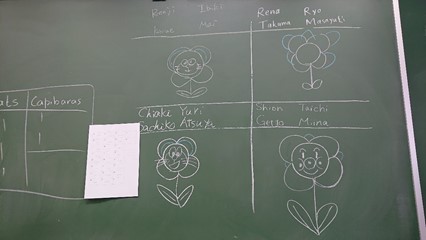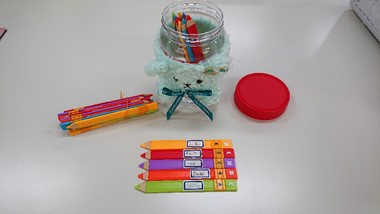Making teaching large classes fun
By Anastasia Nefedova
For me teaching is one of the most exciting and challenging things. I would like to share some tips and ideas I use to teach young adult mixed-level classes. It works very well with my university mixed-level classes in Japan and might easily be adapted for different cultures.
Reward board
 In a setting where students speak the same first language, it is quite challenging to make sure they use English when working with their team members or trying to express their thoughts. What I did to promote the use of L2 was splitting the class into groups of 4–5 students each and drew a table on the board so that they can see which group they belong to. Each group would be given 5 stars at the beginning of each lesson, but if I hear one of the team members speaking L1 (especially, when it can be easily avoided), the whole group would lose a star. On the contrary, if a team member performs extremely well, the group would receive an extra star. I usually award the group with the biggest number of stars at the end of the term with some bookmarks/personal cards to give them a feeling of accomplishment. The main point is to make this competition fun, without putting too much stress on the students who break the rules. It can be avoided by being overly dramatic: ’Oh, no! One of the stars is disappearing… Couldn’t catch it!’
In a setting where students speak the same first language, it is quite challenging to make sure they use English when working with their team members or trying to express their thoughts. What I did to promote the use of L2 was splitting the class into groups of 4–5 students each and drew a table on the board so that they can see which group they belong to. Each group would be given 5 stars at the beginning of each lesson, but if I hear one of the team members speaking L1 (especially, when it can be easily avoided), the whole group would lose a star. On the contrary, if a team member performs extremely well, the group would receive an extra star. I usually award the group with the biggest number of stars at the end of the term with some bookmarks/personal cards to give them a feeling of accomplishment. The main point is to make this competition fun, without putting too much stress on the students who break the rules. It can be avoided by being overly dramatic: ’Oh, no! One of the stars is disappearing… Couldn’t catch it!’
Name sticks
One of my university professors told me that the best music to our ears is the sound of someone saying our own name. Time proved it is crucial to address students by their names to build good relationship and make them feel needed and valued. However, when it comes to teaching large classes in a foreign country remembering names is not an easy task.
 What I do to allow myself some time to memorize their names is to start addressing them by names as soon as possible. A good idea is to make name pencils/sticks. I purchased a set of pencils for grouping online, put blank stickers on each and let students choose the one they liked. Then they wrote their first names and I collected the name pencils. I used them to review the students’ names at home and before the lesson, for roll check (having one student pick up a random name pencil, ask ‘Who is …?’using the name written on it, and ask this person one question in English. After answering, the student would repeat the same procedure until all the students have asked/answered the questions) and now, when I remember all their names, the pencils serve as a great tool for grouping/pairing or asking questions. Students recognize our attempts to remember their names and I feel that letting them memorize their peers’ names plays an important role in establishing a safe and fun learning environment.
What I do to allow myself some time to memorize their names is to start addressing them by names as soon as possible. A good idea is to make name pencils/sticks. I purchased a set of pencils for grouping online, put blank stickers on each and let students choose the one they liked. Then they wrote their first names and I collected the name pencils. I used them to review the students’ names at home and before the lesson, for roll check (having one student pick up a random name pencil, ask ‘Who is …?’using the name written on it, and ask this person one question in English. After answering, the student would repeat the same procedure until all the students have asked/answered the questions) and now, when I remember all their names, the pencils serve as a great tool for grouping/pairing or asking questions. Students recognize our attempts to remember their names and I feel that letting them memorize their peers’ names plays an important role in establishing a safe and fun learning environment.
Plan on the board
 One of the most important points that makes a great lesson atmosphere is to create a safe learning environment. Penny Ur suggests the following advice: ‘Particularly with teenage and adult groups, it’s important to provide the class at the beginning with information about what’s planned for the lesson.’ I have tried this idea many times with my mixed level classes, and it worked better than I expected. At the beginning of each lesson I write a short plan (5 points maximum) on the board using simple words. It usually includes review, new topic title, game, homework. Every time when a part of my plan is done, I refer to the list and check out the finished item. So, the students know how the lesson is progressing and can concentrate better.
One of the most important points that makes a great lesson atmosphere is to create a safe learning environment. Penny Ur suggests the following advice: ‘Particularly with teenage and adult groups, it’s important to provide the class at the beginning with information about what’s planned for the lesson.’ I have tried this idea many times with my mixed level classes, and it worked better than I expected. At the beginning of each lesson I write a short plan (5 points maximum) on the board using simple words. It usually includes review, new topic title, game, homework. Every time when a part of my plan is done, I refer to the list and check out the finished item. So, the students know how the lesson is progressing and can concentrate better.
Letter exchange
Reflecting on my own experience of learning languages, I have often wondered why homework tends to be uninspiring and time-consuming. Lots of fill in the blanks, translation, grammar transformation exercises are worth doing but by the end of the day I felt they were of little use. Yes, I would learn something new, but would it necessarily give me a sense of satisfaction? In many cases, not really. That’s why with my university students I wanted to try something new to make them feel that speaking a foreign language is an extremely rewarding and exciting experience.
This is how the letter exchange started. I wrote a small letter with an introduction and a question for each student and told them that those were for students interested in exchanging letters with me in English. In Japan, where I teach, the tradition of exchanging letters is gradually disappearing now, but it is still considered to be an important part of the culture. Many students got interested in the idea, some of them really wanted to share their ideas, experience and plans. Even though gradually the number of students who exchanged letters decreased, I still think the results have been good. In the future I am planning to have them exchange letters with their teammates — a short message about something they are into recently, a funny story they have heard or a piece of news they found online. I believe that many of them got closer to the real meaning of learning a language — communicating and sharing ideas and feelings. Let’s see how it will work from now on!
Circle activities
Grouping students may be tricky but I try to make sure they have a chance to work with different classmates. As far as I know, one of the most common practices is pairing /grouping stronger students with weaker ones. It is practical in terms of supporting the weaker ones, but I try to put weaker students with the similar level classmates sometimes.
One of the best ways it works in my classes is when we do some circle activities. One of the ideas I use is ‘Compliment circle’. Students make a circle in order from January to December, depending on the month they were born (a great chance to practice when your birthday is and memorizing others’ answers). I start by saying to the student on my left ‘You have a wonderful jacket!’ *. He/she has to react, e.g. ‘Thank you!’, and turn to the person on their left and give them a compliment. When all the students have complimented each other, I ask them to recall what good things they heard about themselves, e.g. ‘I have a wonderful jacket’, etc. It promotes a good atmosphere, is fun and relatively easy to do (pre-teaching some phrases is important) and teaches them the importance of using simple and nice words to make others happy.
*Be clear that no negative comments are accepted.
Post-it feedback notes
When it comes to giving feedback on performance, I find it useful to provide both peer and teacher feedback. In some cultures, it may be challenging to make students share their thoughts on other’s performance. In the setting where I teach, exchanging feedback is not very common — internal group harmony culture dictates its own rules. Students feel shy to point out others’ weak points. So, I tend to use small post-it notes, give a set for each group and give them limited time to write down 2 good points and 1 area of improvement for another group while listening to their presentation/answer. It doesn’t only teach them how to analyze, but also how to make their thoughts clear and short (the post-it notes space is limited). I always specify that we are giving feedback on the overall performance, without pointing out a specific student’s weaknesses or strengths. Working as a part of a team and being able to help each other is very important for a mixed-level environment. They would stick the notes on the blackboard so that other teams can read the feedback and may notice some interesting points for their own performance.
Chants
It is sometimes challenging to get the students repeat a phrase until they can memorize it. When it comes to teaching small talk and common expressions, I enjoy making small chants and ask the students to perform them in pairs/groups with clapping or stomping. One of the most recent ones was about apologizing:
Sorry
My bad
I broke your iPad!
Oh, that’s too bad!
I feel very sad...
First, I prepared strips with each verse and gave one set to each group. They had to put them in the correct order. After that we would read their ideas and I asked them to concentrate on rhyming parts: bad-sad-iPad. Then we practiced saying the chant and clapping to make sure the stress was correct. Last was a small class performance, with one side saying the first part and the other side saying the second. To make it more fun, I made sure that I erased the chant from the board and added a little bit of speed at the end to see if they could keep the rhythm till the end. I believe that chants are helpful and do not put too much stress on lower level students — they are more comfortable with choral repetition and have more opportunities to practise. Moreover, the bodily kinesthetic part plays an important role in stimulating the long-term memory while having fun clapping or moving.
I hope that using some of these tips will help many teachers who have started teaching large classes. From my experience, it is indeed stressful but seeing my students progressing and having fun is the best reward for me.
|
References: Ur, P., ed., Penny Ur’s 100 teaching Tips, 1st ed. Cambridge University Press |
 |
Author's bio: Anastasia Nefedova has been teaching English for 5 years and currently works in a big language center in Shizuoka, Japan. Being a native Russian speaker, she learnt English at university and then took CELTA at Teaching House New York. Anastasia's interests include learning foreign languages, travelling and reading. |